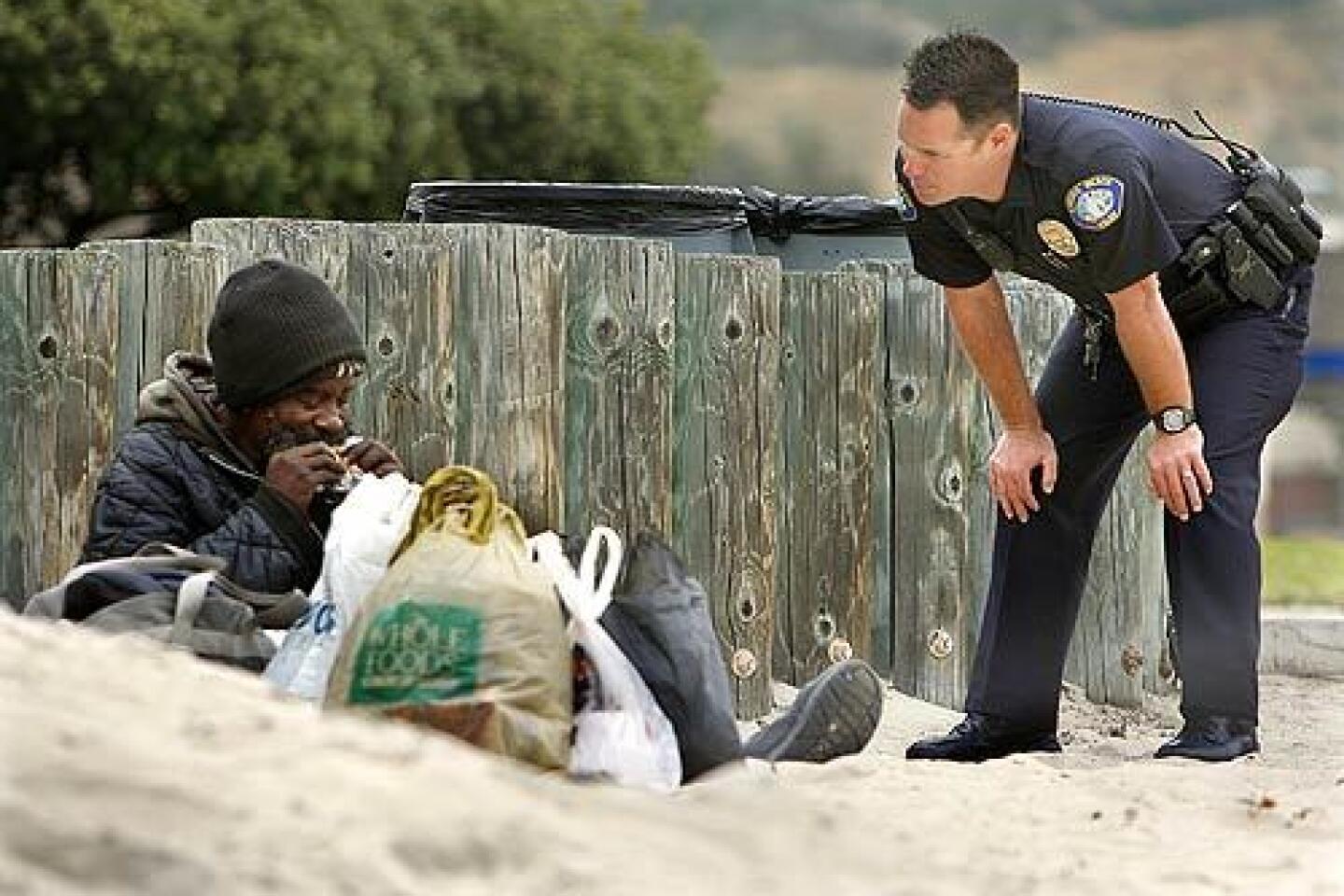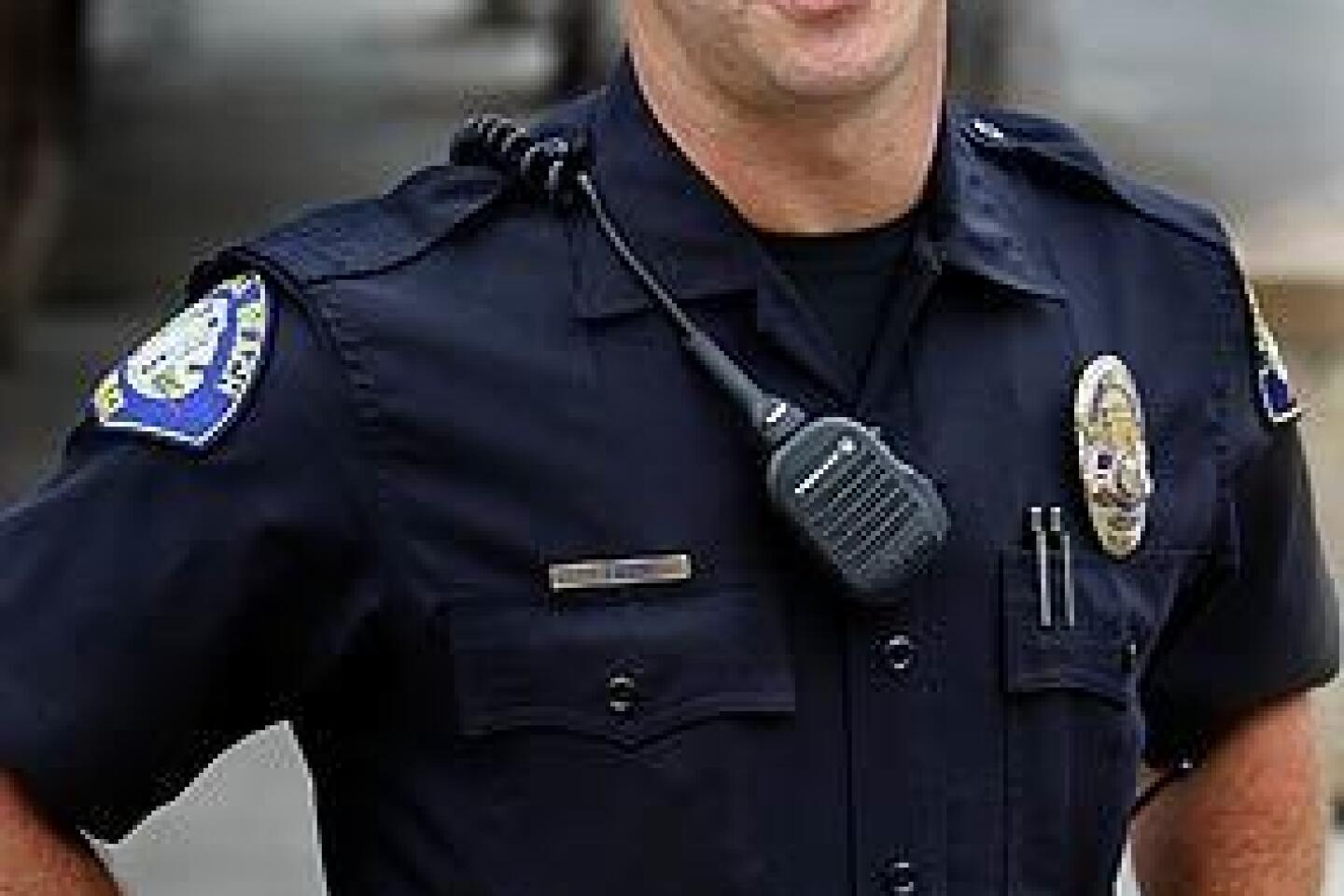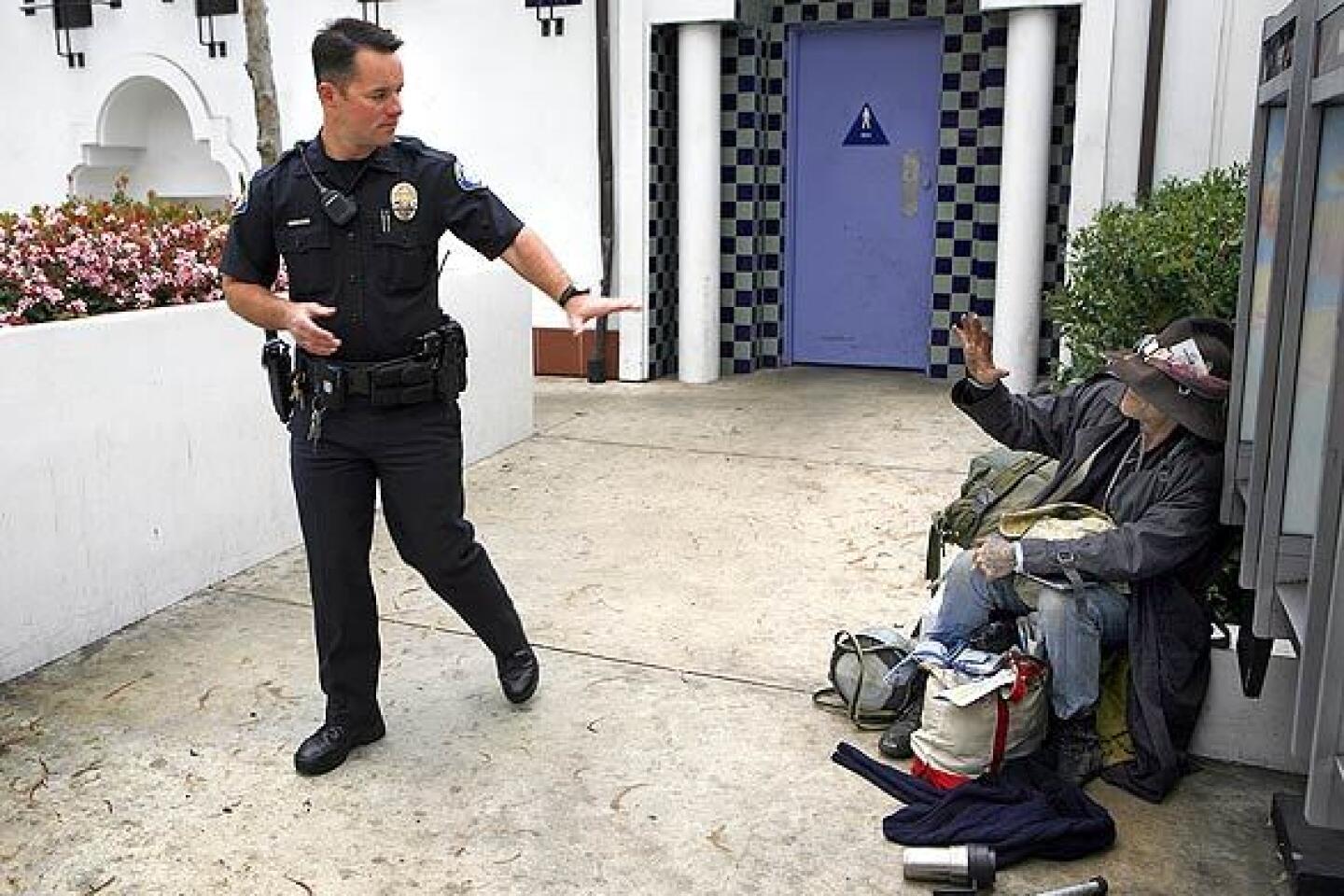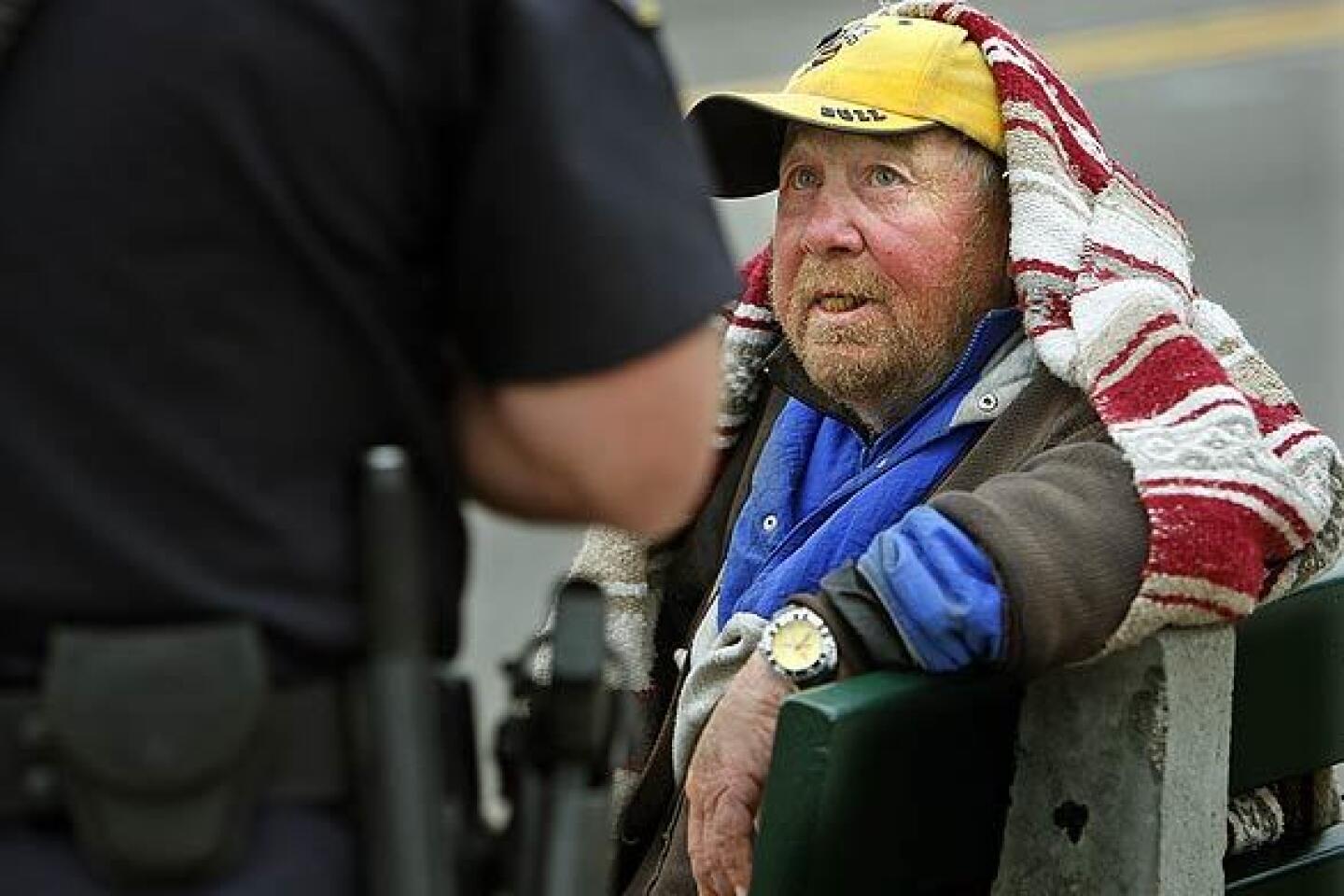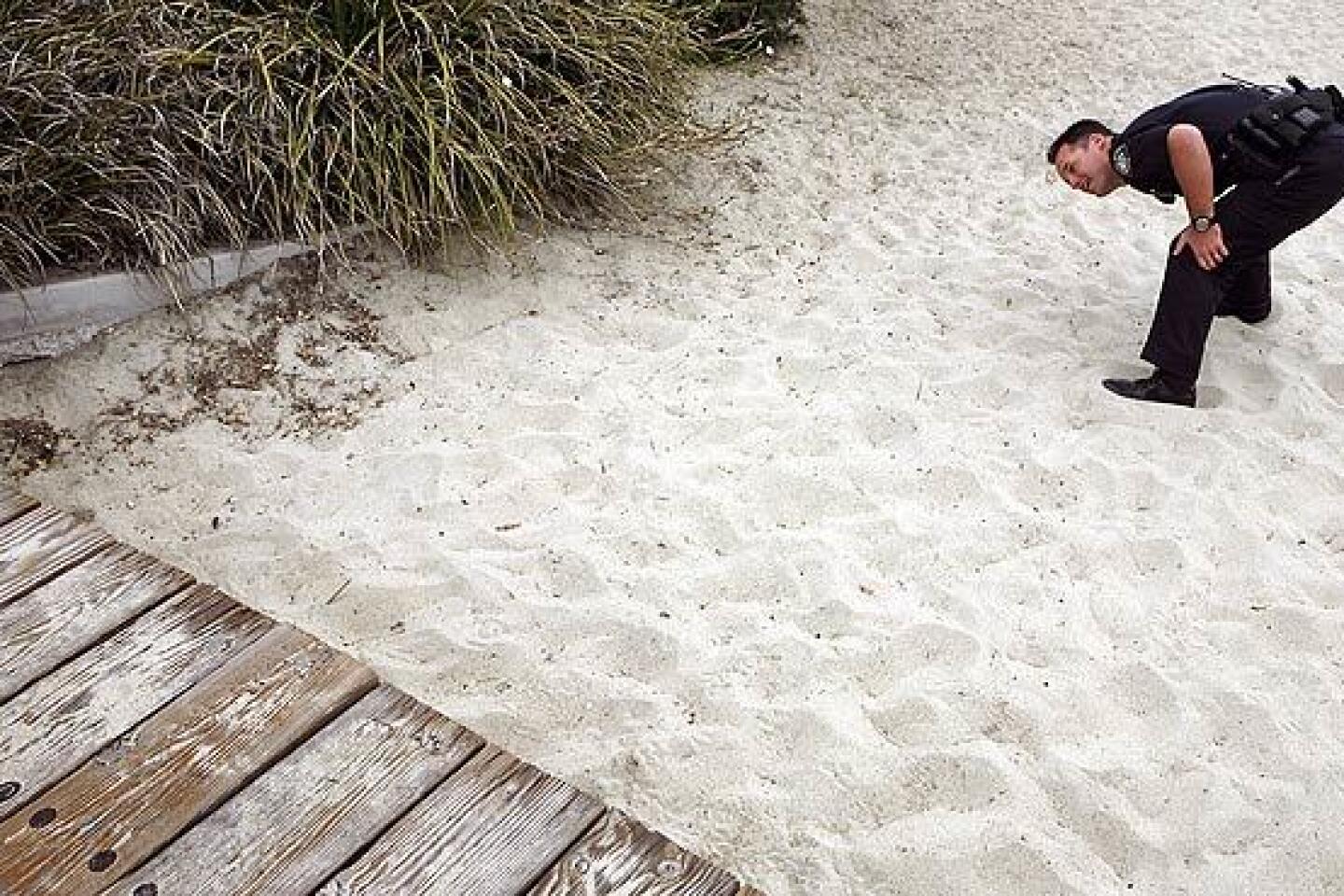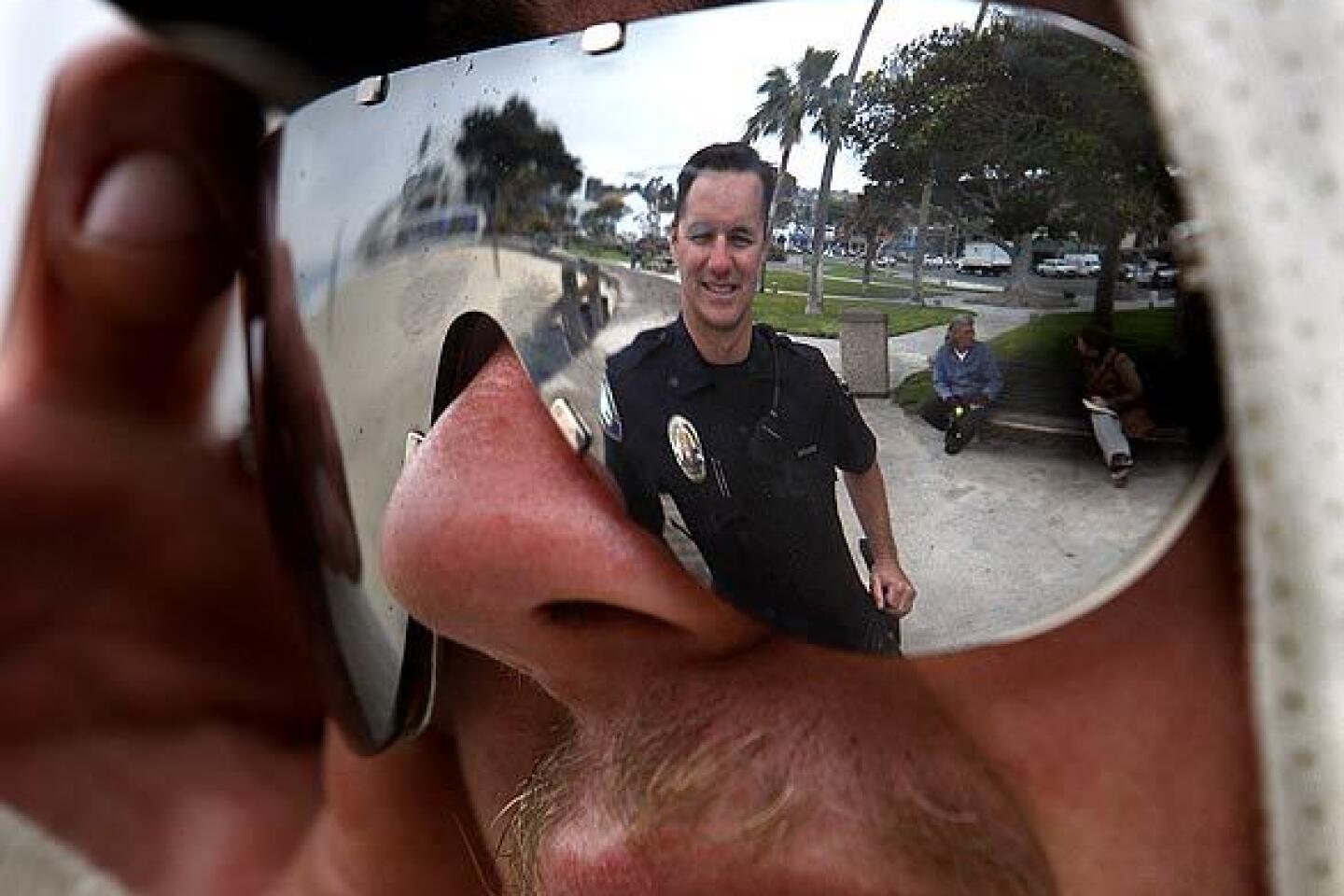Officer gets friendly with Laguna Beach’s homeless
- Share via
“You just come in to Laguna Beach, brand new?” Police Officer Jason Farris asked the weathered man in the brown, floppy hat.
Lolling at the edge of the city bus depot -- bedroll, canteen and cane plunked by his side -- the man stiffened warily. But Farris was undeterred.
Less than 15 minutes later, Johnny, as the man calls himself, was chattering about life as a tattoo artist as he flashed the cop photos of his former wife.
So unfolded another morning for Farris, Laguna Beach’s newly minted community outreach officer.
The 3-month-old position is part of a wide-ranging effort by the city to end the panhandling, public urination and camping that have drawn complaints from residents and merchants alike. But Farris is no ordinary cop: He strolls Laguna’s streets and sand, greeting by name the people who sleep under the boardwalk or beneath bushes and stopping to talk rather than shooing them away.
“You can’t force them into getting off the street,” Farris said. “It’s not a crime for them to be homeless.” He aims to build trust with the city’s down and out, coaxing them to seek help.
Besides hiring Farris, a task force assembled by the city last year has drafted more than a dozen other recommendations for how to move Laguna’s 50 or so chronically homeless people off the streets. These include a public information campaign to discourage giving change to beggars and five specially labeled parking meters that would collect money for local homeless services, modeled after a program in Denver.
Additionally, advocates are looking for land to expand the Resource Center, which offers meals, groceries, clothes and other services to those in need. City officials hope to enlarge the facility into a one-stop shop with mental health aid and substance abuse counseling.
Besides the center, the upscale enclave of about 25,000 -- where the median home price is almost $1.5 million -- has a cold-weather shelter that rotates among local churches, a residential shelter with strict rules for admission, and regular free meals.
Yet in a survey last year, residents named the homeless issue their No. 2 concern, behind traffic.
“Too often we see ‘The Real Housewives of Orange County’ and think that that’s how everybody lives,” said Dawn Lee, executive director of the O.C. Partnership, a nonprofit group that links homeless agencies across the county.
City officials consider their strategy toward the homeless, with the emphasis on outreach, a novel one. “It is not just an enforcement-based approach. It is really more of a balanced approach,” said Assistant City Manager John Pietig. “We feel like that reflects the character of the community.”
Homeless people -- many of whom have lived in Laguna for years -- are “part of the landscape,” said Gregg Meincke, 36, manager of a swanky restaurant on the city’s main drag.
Whether drawn to the stunning scenery or canyon hideaways to sleep in, the homeless population has held steady for years. Street people regularly approach diners on the restaurant’s outdoor patio, Meincke said, but it’s no big deal.
“Laguna’s a really cool, eclectic community -- not like the rest of Orange County,” said Meincke, who’s lived there 13 years. “People deal with them in a different way than they would in Newport Beach.”
But for Ashwin Balan, owner of the Village Mart gas station and convenience store across Coast Highway from Main Beach, the homeless situation hasn’t exactly been a breeze. He said he had to lock up the shop’s ladders after homeless people used them to reach the roof to sleep, and he installed a coin slot on the bathroom door to prevent them from monopolizing the lavatory.
Yet employees will sometimes give familiar faces a free hot dog; the regulars, Balan said, will always return to pay.
“People are actually really nice here,” said Robert, 49, resting on a beach-side bench one recent morning. He’s looking for work, he said, but it’s tough with his bad back.
“This guy here is totally cool,” said Robert, gesturing to Farris, who was listening intently as another homeless man poured out his troubles about paying child support.
Laguna’s approach to combating homelessness stands out in Orange County, the O.C. Partnership’s Lee said, and is “what every city should be doing.”
“In Orange County,” she said, “plenty of cities are pushing people to the next city, saying, ‘We don’t want homeless people here.’ ”
The demographics of Laguna’s homeless also buck Orange County trends: Most of the county’s homeless are families, while nearly all of the transients in Laguna Beach are chronically homeless adults -- those who have been living on the streets for months or years and often have mental or physical disabilities.
The county recorded an estimated 35,000 instances of homelessness over the last year, Lee said. A person could be counted more than once.
Santa Monica, which has taken a similar, service-oriented approach to its homeless population, has an estimated 300 to 600 people living on city streets, with more in residential programs.
“It does impose a strain on the community if people are on the streets indefinitely,” said Colin Henderson, a retired Episcopal priest and longtime Laguna resident who two decades ago helped establish the city’s first shelter for homeless adults.
Yet Laguna is “a small city; they can’t do it alone,” Lee said.
In his one-man operation, Farris encouraged the man sitting on the beach surrounded by plastic bags to get a hot shower; checked for the owner of camping gear stowed under the boardwalk; and saluted the local chess master as he began another day of games at the shore.
But he rejects comparisons to social work.
“My job is not to make them comfortable on the street,” Farris said. Rather, he reminds people to take their medication or connects them with rides to get help.
In three months on the beat, Farris estimates, he has helped connect at least 10 people with some kind of assistance.
“If we don’t do something, they will not get better,” he said. “That’s the bottom line.” But if someone is breaking the law, they’ll receive no special treatment.
Farris’ community-based efforts are modeled in part on the work of Santa Ana Police Officer Randy Beckx, who has worked alongside a mental health clinician for close to a decade to help the estimated 2,000 chronically homeless there.
Beckx has met with several police departments in the county to help them with outreach to the homeless.
Rather than arresting people, Beckx tries “to address the underlying causes” of their homelessness. Laguna plans to evaluate Farris’ progress this summer; a community forum on the issue is scheduled for June.
Councilman Kelly Boyd, who’s helped lead the push to combat homelessness, acknowledges that the process will “take a while.” Because of the relatively limited services in town, he’s not concerned that the city’s efforts will attract more of the homeless.
As the man in the floppy hat launched into tales of his brother in Oklahoma City, Farris leaned down and listened, jotting down a few notes.
“Next time you come through Laguna Beach, look for me,” Farris said, after examining Johnny’s identification, extracted from a rubber band-bound makeshift wallet.
As Farris walked away, eyes roaming for his next hard-luck customer, Johnny lingered by the curb. “Your smile is real,” he called after the police officer. “It goes to your eyes.”
susannah.rosenblatt @latimes.com
More to Read
Sign up for Essential California
The most important California stories and recommendations in your inbox every morning.
You may occasionally receive promotional content from the Los Angeles Times.
